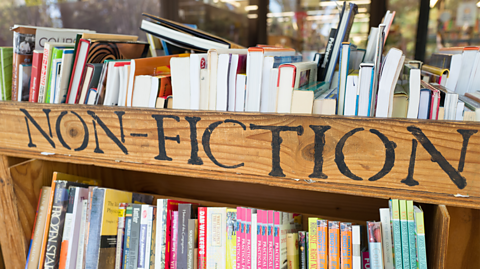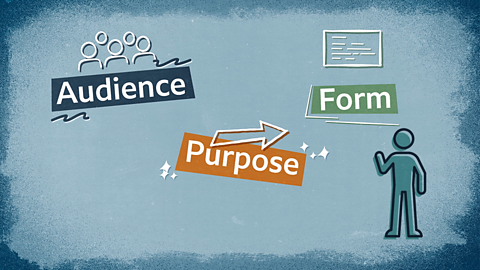Try not to groan!
When I want to read fiction, I go to the library.
When I want to read non-fiction, I go to the truthbrary.
Introduction to language in non-fiction texts
Non-fiction texts deal with real-life events and issues.
Non-fiction writers make language choices to present their viewpoint, influence the reader and create a particular effect in order to fulfil the intended purpose of their text. It is important that we know how to identify and interpret these language choices in order to fully understand the ideas the writer is communicating.
Video about investigating language in non-fiction
Find out how to investigate language in non-fiction texts
What is a non-fiction text?
A non-fiction text is any piece of proseAny written work that follows a basic grammatical structure, using language that follows the natural patterns of everyday speech (unlike poetry). writing that is based on facts or real events, people or ideas, rather than something that is fictitious (made up and imaginary).
It is a broad genre that includes:
- advertisements
- autobiographies
- biographies
- diaries
- essays
- information leaflets
- newspaper and magazine articles
Establishing tone
Tone refers to the mood of the text.
The tone of a text is deliberately chosen by the writer in order to make the reader feel a certain way. This is designed to help the writer achieve their overall purpose and communicate their viewpoint.
In order to determine the tone of a text, we need to analyse the writerâs choice of vocabulary, imagery and language techniques.
Vocabulary choices
Itâs useful to look at how a choice of a word or phrase can change the impact of a text. For example:
a) The coral reef has been damaged by an increase in tourism.
b) The coral reef has been devastated by an increase in tourism.
At first glance the two statements look similar. But the choice of the word devastated increases the impact of the second example, emphasising the level of destruction tourism has caused and focuses the reader's attention on the seriousness of the issue. It helps to fulfil the writerâs purpose of informing and persuading the reader that tourism is not always a good thing.
Paying close attention to individual words and phrases the writer has deliberately chosen to use will help you to understand what impact a writer intends.
Literary and persuasive techniques to engage a reader
The writer may use a language technique to draw attention to an important idea or point. The effect of the language technique will depend on how it is being used. For example:
- Tricolon (also known as Rule of Three or Triples): Three words or phrases in a row within a sentence to emphasise a positive or negative point.
- Hyperbole: Exaggerated statements or claims for emphasis (not meant to be taken literally).
- Emotive language: Words and phrases deliberately and intentionally used to make your reader feel certain emotions (e.g. sadness, worry, urgency etc.).
- Expert quote: A quotation taken from an expert in the topic about which you are speaking which supports the point you are making, giving it more authority.
- Repetition: A key word or phrase said more than once to reinforce a point. For example, âWe have seen what we need to do. Now we need to do it and do it togetherâ.
- Statistic: A percentage used to demonstrate a point, giving it more authority.
- Alliteration: Repeating a particular sound.
- Imagery: Carefully selecting visually descriptive language, creating images in order to have a particular effect upon the reader.
The writer's purpose and viewpoint
By investigating vocabulary and language choices, you can begin to determine the writerâs overall aim and examine how and why the writer could be trying to influence the reader. For example:
A writer may be using persuasive language to convince the reader to agree with their viewpoint in a magazine article, or to encourage them to buy something in an advertisement.
A writer might use language to amuse or entertain the reader and present a topic in a light-hearted way.
Analysing language patterns
Itâs also useful to consider patterns in how words and phrases are used by a writer to determine their aim.
A writer may deliberately use lots of positive abstract nouns â like dream, love, peace, happiness â in a perfume advertisement to give the writing a sophisticated tone and to offer the promise of delivering desirable concepts (in order to persuade us to buy it).
In a piece of travel writing about rock climbing, the writer may use lots of action verbs â like reaching, grasping, leaping â to create a strong sense of physical drama.
In a piece of news reporting about, for example, a war, the writer may use a semantic fieldA group of words all related to the same concept or idea. of war â like fighting, bombs, shooting, death â to inform us of what the situation is like.
Try to notice when a writer does something more than once, and think about where your attention is being directed.
Key points
Remember:
Investigating language will make you more aware of the different ways that texts work to influence their readers. Writers may use language choices to shock, advise, amuse, inform, persuade â or a mixture of these. Seeing these techniques in action will also help you learn how to use them effectively in your own writing.
Test your knowledge
Play Bitesize secondary games. gamePlay Bitesize secondary games
Have fun playing science, maths, history, geography and language games.

More on Critical reading
Find out more by working through a topic
- count5 of 5

- count1 of 5

- count2 of 5
